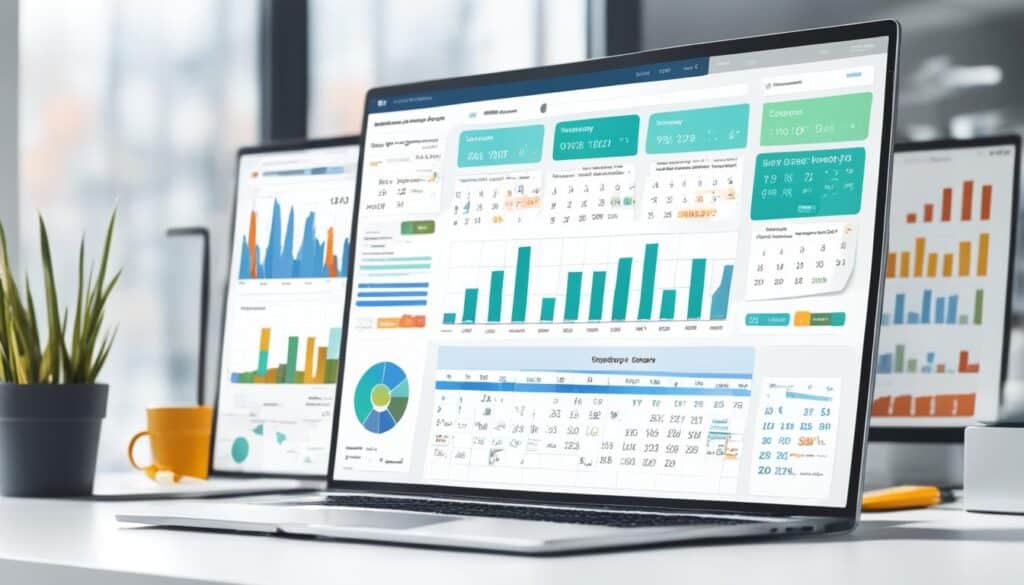
Seasonal SEO is an essential strategy for businesses looking to boost online visibility and capitalize on market trends and consumer behavior shifts. By aligning your website and content with the changing seasons and holiday periods, you can drive targeted traffic to your site and increase conversions. To implement effective seasonal SEO, careful planning and strategizing are key. Let's explore some valuable tips and strategies for successful seasonal SEO campaigns.
Key Takeaways:
- Seasonal SEO helps businesses capitalize on market trends and consumer behavior shifts.
- Research and identify relevant seasonal keywords to optimize your website content.
- Create dedicated landing pages and optimize meta tags to highlight your seasonal content.
- Develop engaging and shareable seasonal content to attract more traffic and social signals.
- Monitor the performance of your campaigns and make adjustments based on data analysis.
Research and Identify Seasonal Keywords
When it comes to planning for seasonal SEO, the first and most crucial step is to research and identify relevant seasonal keywords. Understanding how consumers search for products and services during specific seasons or holidays is key to optimizing your website and content effectively. This requires conducting thorough keyword research to uncover popular search terms and phrases related to your industry during the target season.
One effective approach to finding seasonal keywords is to analyze consumer search behavior. By studying the search trends, you can gain insights into the specific needs and preferences of your target audience during different seasons. Look for long-tail keywords that reflect these preferences and use them strategically throughout your website content, meta tags, and titles.
By incorporating these seasonal keywords into your online presence, you can improve your search engine rankings and attract more organic traffic. Long-tail keywords have been shown to be particularly effective in driving targeted traffic because they capture the intent of users more precisely.
For example:
Celebrate the Season with Festive Decorations
Looking to spruce up your home this holiday season? Our wide selection of festive decorations will transform any space into a winter wonderland.
When optimizing your website and content, be sure to prioritize the user experience. The use of relevant keywords should enhance your content and provide value to your readers, rather than simply serving as a means to boost search engine rankings.
Next, let's explore how to optimize your website for seasonal content.
Optimize Your Website for Seasonal Content
Now that you have identified the seasonal keywords, it's time to optimize your website to capitalize on the seasonal content. By creating dedicated landing pages or sections on your website that focus on the specific season or holiday, you can enhance your online visibility and attract targeted traffic. To ensure that search engines recognize the relevance of your content to seasonal searches, incorporate relevant keywords into your meta tags, page titles, and headings.
But don't stop there â internal linking is an important aspect of website optimization for seasonal content. By strategically linking your seasonal pages to other related pages on your website, you can create a cohesive user experience and improve the visibility of your seasonal content.

Implementing proper internal linking allows users to navigate seamlessly between your seasonal content and related pages, increasing engagement and time spent on your website. Furthermore, it signals to search engines that your website provides valuable and interconnected information, potentially boosting your search rankings.
By optimizing your website for seasonal content through landing pages, meta tags, page titles, and internal linking, you can improve the visibility and user experience of your seasonal campaigns. Now let's delve into creating engaging and shareable seasonal content.
Create Engaging and Shareable Seasonal Content
To maximize the impact of your seasonal SEO efforts, it's crucial to create engaging and shareable seasonal content. Engaging content is key to capturing the attention of your target audience and keeping them hooked. By providing valuable information, tips, and insights that resonate with your audience, you can create content that they'll want to share with others.
One effective way to create engaging seasonal content is through blog posts and articles. These allow you to dive deeper into seasonal topics, share unique perspectives, and provide in-depth information. Craft well-researched and well-written articles that address the interests and needs of your target audience.

In addition to articles, infographics are another great tool for creating engaging seasonal content. Infographics present information in a visually appealing and easy-to-digest format, making them highly shareable. Design eye-catching infographics that highlight seasonal trends, tips, or statistics relevant to your industry.
Videos are also incredibly effective for engaging your audience and sharing seasonal content. Create videos that showcase seasonal products, demonstrate how-tos, or share stories related to the season or holiday you are targeting. Share these videos on your website, social media platforms, and video sharing websites to reach a wider audience.
"Engaging and shareable content has the potential to attract more traffic, backlinks, and social signals, which can boost your search engine rankings."
Once you have created your engaging content, it's important to share it with the world. Share your blog posts, infographics, and videos on your website and promote them through your social media platforms. Encourage your audience to share your content by including social sharing buttons and calls to action. By generating buzz and encouraging social shares, you can increase the reach and visibility of your content.
Key takeaways:
- Create engaging and shareable seasonal content to capture and retain your audience's interest.
- Develop blog posts, articles, infographics, and videos that provide valuable information and resonate with your target audience.
- Share your content through your website and social media platforms to increase its visibility.
- Encourage social sharing by including social sharing buttons and calls to action.
Monitor Performance and Make Adjustments
Once your seasonal SEO campaigns are live, it's crucial to monitor their performance and make adjustments as necessary. By closely tracking key metrics and analyzing data, you can optimize your campaigns to achieve better results. Here are some essential steps to follow:
Step 1: Performance Monitoring
Use reliable SEO analytics tools to monitor the performance of your seasonal SEO campaigns. Keep track of important metrics such as organic traffic, keyword rankings, and conversion rates. This data will provide valuable insights into the effectiveness of your strategies and help identify areas for improvement.
Step 2: Data Analysis
Thoroughly analyze the data collected to gain a deeper understanding of your campaign's performance. Look for patterns, trends, and correlations to identify what strategies are working and what may need adjustment. Dig into the SEO metrics to uncover valuable insights that can guide your decision-making process.
Step 3: Traffic Sources
Pay close attention to the sources of your traffic. Analyze which channels and platforms are driving the most visitors to your website. This analysis can highlight areas where you can optimize your campaigns further. For example, if you notice a significant portion of your traffic comes from social media, you can allocate more resources to social media marketing for better results.
Step 4: Conversion Rates
Monitor your conversion rates to assess the effectiveness of your seasonal SEO campaigns in driving desired actions, such as purchases or sign-ups. Analyze the conversion funnels to identify any barriers or bottlenecks that may be hindering conversions. By optimizing your content, keywords, and promotional efforts based on these insights, you can improve your conversion rates and maximize the ROI of your SEO campaigns.
Step 5: Make Adjustments
Based on your data analysis, make informed adjustments to your content, keywords, and promotional strategies. Tweak your website content to align with the search intent of your target audience. Optimize your meta tags, headings, and alt text to improve your search engine rankings. Adjust your promotional efforts to focus on the most effective channels for driving traffic and conversions. Continually monitor the impact of these adjustments and iterate as needed to achieve optimal results.
By monitoring the performance of your seasonal SEO campaigns and making data-driven adjustments, you can ensure that your efforts are driving the desired results. With careful analysis and optimization, you can maximize the effectiveness of your seasonal SEO and achieve your business goals.
Prepare for Future Seasons and Holidays
Planning ahead is crucial when it comes to leveraging seasonal SEO for future seasons and holidays. By developing a content calendar that outlines the key seasonal events and holidays throughout the year, you can stay organized and ensure you have ample time to create and optimize your seasonal content.
Conduct ongoing research to identify emerging trends and shifts in consumer behavior that may impact your seasonal SEO strategies. This will help you stay ahead of the curve and maximize the effectiveness of your campaigns. By understanding the upcoming holidays and future seasons, you can optimize your website, create relevant content, and target the right keywords to attract and convert more customers.
Remember, staying proactive and planning ahead is the key to success in seasonal SEO. By maintaining a well-crafted content calendar and conducting thorough research, you can consistently deliver impactful and timely content that resonates with your target audience.
FAQ
What is seasonal SEO?
Seasonal SEO is a strategy that involves aligning your website and content with the changing seasons and holiday periods to boost your online visibility and drive targeted traffic to your site.
Why is seasonal SEO important for businesses?
Seasonal SEO is important for businesses because it allows them to capitalize on market trends and consumer behavior shifts, ultimately leading to increased visibility, more organic traffic, and higher conversion rates.
How do I research and identify seasonal keywords?
Researching and identifying seasonal keywords involves conducting thorough keyword research to uncover popular search terms and phrases related to your industry during the target season. Look for long-tail keywords that reflect the specific needs and preferences of your target audience.
How can I optimize my website for seasonal content?
To optimize your website for seasonal content, create dedicated landing pages or sections that focus on the specific season or holiday. Use relevant keywords in your meta tags, page titles, and headings. Additionally, leverage internal linking to connect your seasonal content with other related pages on your website.
What types of seasonal content should I create?
To maximize the impact of your seasonal SEO efforts, it's important to create engaging and shareable content such as blog posts, articles, infographics, and videos that are specifically tailored to the season or holiday you are targeting. Focus on providing valuable information, tips, and insights that resonate with your target audience.
How should I monitor the performance of my seasonal SEO campaigns?
To monitor the performance of your seasonal SEO campaigns, use SEO analytics tools to track key metrics such as organic traffic, keyword rankings, and conversion rates. Pay attention to the sources of your traffic and identify areas where you can optimize your campaigns further.
How can I prepare for future seasons and holidays?
To prepare for future seasons and holidays, develop a content calendar that outlines the key seasonal events and holidays throughout the year. Conduct ongoing research to identify emerging trends and shifts in consumer behavior that may impact your seasonal SEO strategies.











